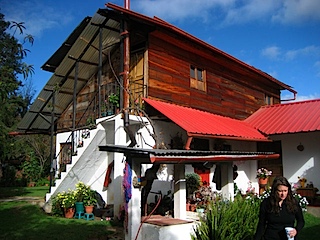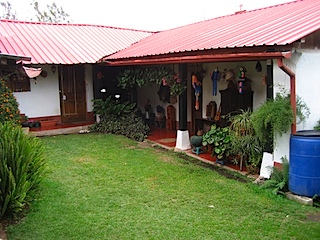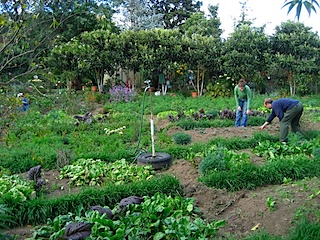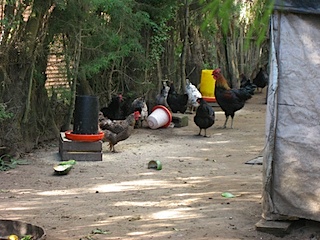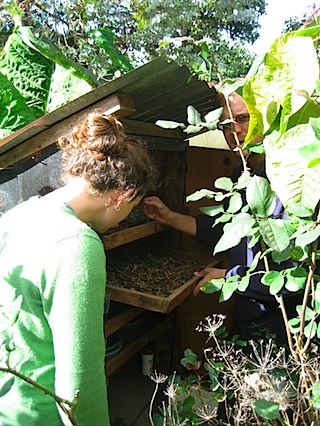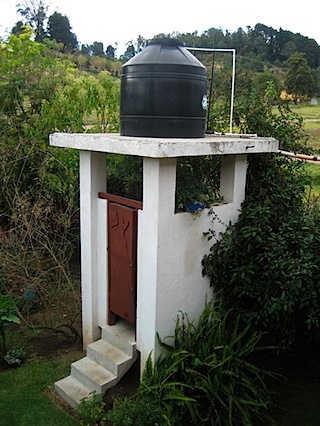I talk occasionally about farming because it interests me. Not the John Deer-driving, tobacco-chewing, grain-elevator-haggling kind of farming. I’m talking about what some deride as “hippie farming”: small-scale, organic, diverse, sustainable. I catch glimpses of it in Guatemala, since that is how the Maya have done it for millenia. I don’t mean to romanticize Mayan rural life: it was short and hard back then, and tends to be nowadays as well. But they had some good ideas worth remembering, and some of them still practice it: things like intercropping corn and beans (to close the soil nutrient cycle) or fertilizing with aged sheep dung.
A few weeks ago, however, we had a series of fortunate accidents that exposed us to a whole new world of hope, inspiration, and information. It started innocently enough: we went to visit a friend of ours who lives in a village outside of San Marcos, a day’s journey south of here. He’s a former Peace Corps volunteer who married a Guatemalan national, and one of my best friends here in Guatemala. Perhaps it’s because we’re about the same age, or have the same stupid sense of humor?
Finding his house was easier than anticipated, partly because every other person we met at the bus station saw we were gringoes, and said things like “Are you going to see Don Ma-Kay-Lee?” “The driver knows his house, don’t worry!” “I can drop you off right in front, it’s the house with all the flowers.” Peace Corps volunteers are really good at commnuity integration, and I guess that skill doesn’t go away after you end your service. The locals were all SO excited to show us they were a part of the same community as him.
He and his wife Carolina welcomed us into their home for the weekend. And what a home! It used to belong to her father, and they have since put a ton of work into it. What was once an old adobe house and a tiny barn are now a lot like the cool Galician villas Emily and I saw when we walked across Spain in 2006. Even the smells were right: drying herbs, flowers, old wood. We took a little side trip to the local hot springs, where Emily got to talk to all the local girls about whatever girls talk about (!), then we spent the rest of the time hanging out in their villa.
The property was used as a cornfield for ages before they moved in, but now they’ve converted it into a mini-farm. They grow an astounding variety of vegetables, herbs, fruits, and flowers. They also raise chickens, and Carolina sells most of the eggs to a vendor in town.
Here we see a home-made solar seed dryer. Back in his Peace Corps days, Makali worked in the now-defunct Seed Security program. He still harvests all his plants for seeds, dries them, and stores them for the following season. He also constructed one of the nicest LASF composting latrines I’ve ever seen. It even doubles as a water tower.
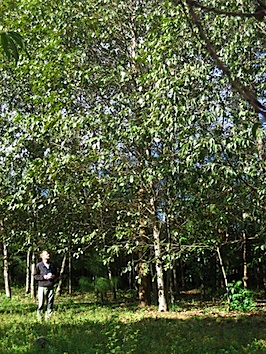 He then showed us the trees the locals use to harvest leaves for tamales. “Our neighbors all complained about how there aren’t any of these trees around anymore, so I planted some. Now I give them leaves from time to time when they want to make tamales. I told them they could plant their own trees and never have to worry about running out, but you know how people are around here,” he said with a shrug. They also planted a woodlot on the back quarter of their property. Trees are becoming a scarce resource in Guatemala, and planting more is the responsible thing to do. This forest was planted just five years ago, and look at it!
He then showed us the trees the locals use to harvest leaves for tamales. “Our neighbors all complained about how there aren’t any of these trees around anymore, so I planted some. Now I give them leaves from time to time when they want to make tamales. I told them they could plant their own trees and never have to worry about running out, but you know how people are around here,” he said with a shrug. They also planted a woodlot on the back quarter of their property. Trees are becoming a scarce resource in Guatemala, and planting more is the responsible thing to do. This forest was planted just five years ago, and look at it!
We talked about our dreams of small-scale organic farming over the dinner table. “I’ve never heard any volunteer tell me they want to be a farmer,” Carolina said. “Why do you want to be a farmer?”
Emily explained that we think it’s the responsible thing to do, for us and for the environment, and that viewpoint really struck a chord with her. I feel like it requires a wide range of knowledge in many different areas, and it’s something challenging to do right. I like challenges.
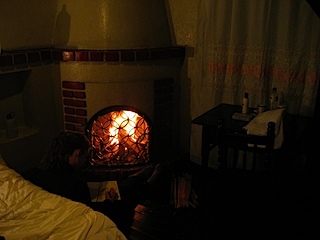 Our heads were full of farming thoughts when we got back to Xela, our overnight stop on the long journey home. Xela is nice to visit on occasion; it’s the biggest city in Guatemala besides the crime-infested capitol, and sports many luxuries we rarely enjoy: Indian cuisine, a Menonite bake shop, and even a hotel with hot showers and fireplaces.
Our heads were full of farming thoughts when we got back to Xela, our overnight stop on the long journey home. Xela is nice to visit on occasion; it’s the biggest city in Guatemala besides the crime-infested capitol, and sports many luxuries we rarely enjoy: Indian cuisine, a Menonite bake shop, and even a hotel with hot showers and fireplaces.
Xela also has coffee shops (wheee!) so we took advantage of the rare opportunity to enjoy some banana frappaccino/ chocolate cookie/ free WiFi action. Xela is also a hot location to study Spanish, and we ended up talking to the fellow across the table from us, as happens in bohemian coffee shops. His name was Ryan.
“I’m studying Spanish so I can communicate better with my field workers on the farm,” he explained when asked.
This got our attention. “You’re a farmer? Where?” Emily asked.
He explained to us that he is an organic strawberry and spinach farmer near Pescadero, California. How exciting! That’s only a few minutes away from the summer camp where we used to work, and we know the region well. It’s gorgeous.
“Are you doing OK? We keep hearing it’s hard to make a living that way,” I said.
He laughed. “It’s work. But I’ve been doing it for five years, and I don’t have to take a second job.” He went on to explain that he has one business partner, two interns, and hires half a dozen Mexicans seasonally. He farms 12 acres, and has a 5-year lease along with his partner. Blue House Farm, his agribusiness, pays the bills and leaves him enough money to vacation all of January (and come to Guatemala, apparently). This was all very inspirational, and we admitted that we want to do something similar when we are done with Peace Corps.
“Go for it!” he said, emphatically. “The market is still expanding for small-scale organic farming.” We explained that we want to use a CSA as our primary distrubution method, and Ryan smiled. “That’s about half of our business; we have 200 CSA members and we do two drops a week. The other half is direct sales to restaurants.” It’s a proven business model that works, but it was great to meet someone who was actually experiencing success with it RIGHT NOW. “This is a really good time to get into farming,” he contined. The USDA has changed it’s focus a lot in the last year or two, and is now starting pilot programs to encourage younger people to get into farming. Ryan’s business has received several federal grants (that’s not a loan, folks; grant=free money) for irrigation infrastructure, fencing, an environmental improvement plan, and so forth. This year he was expecting about $30,000 from Uncle Sam to improve his farm further. “You are in luck,” he said. “Most of the really good grants are for startup farm businesses, and if you’re just beginning, you can get in on the ground floor.” He gave us some websites to look into, as well as his business card and permission to visit his farm and ask questions when we get back to the US.
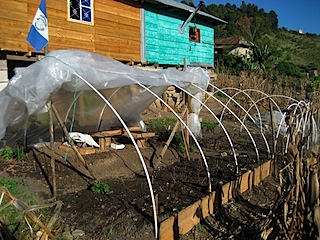
That brings us back to life in our village. “Summer” arrived last week, with the cold misty rains departing and leaving us with pounding sun and tee-shirt weather. Soon the stream will dry up, and we’ll have to carry water. These last three days have felt like we’ve been transported to Hawaii, and I sit in my house in the evening in sandals and without a jacket. I know it’ll only last about three months. To the locals, it signals the beginning of planting season and their chance to get the fields turned and the seeds in place before the rains return.
This year we’re going to experiment with the Grow Biointensive system. That means starting all of our seeds in flats. I’ve set the second week of February as our transplant date, so I’ve got a few weeks to get the chicken fences up, the oak leaf mulch carried, and the planting beds hoed. It is all moving along well.
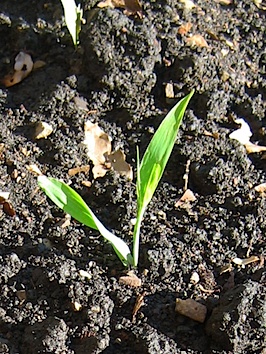 Chalio still shows great interest in the garden and comes by in the evenings when I water, mostly just to hang out. “Mira, hay ixim,” he said, pointing at some green weeds sprouting at the edge of my newly-tilled bed. Really? Those weeds are corn? I dug one up, and sure enough, the roots were wrapped in a split corn kernel. How dumb am I, thinking a Mayan kid couldn’t identify CORN? I transplanted them all into the beds, and they are already 6 inches high.
Chalio still shows great interest in the garden and comes by in the evenings when I water, mostly just to hang out. “Mira, hay ixim,” he said, pointing at some green weeds sprouting at the edge of my newly-tilled bed. Really? Those weeds are corn? I dug one up, and sure enough, the roots were wrapped in a split corn kernel. How dumb am I, thinking a Mayan kid couldn’t identify CORN? I transplanted them all into the beds, and they are already 6 inches high.
The learning never stops. A few days ago, a truck came down the road, loudspeakers blaring that they were selling potatoes and seed potatoes. A few weeks back, Emily and I decided we want to try growing potatoes, so I joined the half-dozen villagers gathered around the truck. Nas and Manuels’ wives (both named Lina) were there, talking with the potato vendors. A bit of haggling and 60Q later, I was the proud owner of a 100-pound bag of seed potatoes. I lugged them back up the hill on my back, to the amusement of all the locals that think gringoes can’t carry a quintal, and dropped them by our front door.
“Can we eat them too?” Emily aked. I’m ashamed to admit, I have no idea what differentiates a “seed potato” from a regular potato. Maybe I should ask Uncle Leon; he’s an old-skool Idaho potato farmer.
“I bought this bag of potatoes,” I told Nas Palas the following day. “It’s way too much for us, so you can take as many as you want when you go to plant yours.” He looked at the bag leaning against the house.
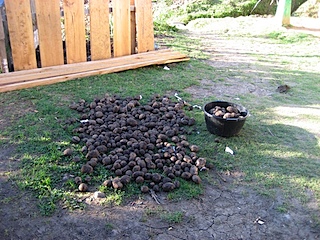 “You have to take them out of there,” he warned, eyebrows rising. “Otherwise, they’ll rot. You have to spread them in the sun to get them all dried out.” Aha, another secret I should know. As Chalio and Alberto helped me scatter them in the yard, I remembered Chalio earlier saying something about putting the potatoes in the bin under the house. Hmm. I should listen to that kid more carefully.
“You have to take them out of there,” he warned, eyebrows rising. “Otherwise, they’ll rot. You have to spread them in the sun to get them all dried out.” Aha, another secret I should know. As Chalio and Alberto helped me scatter them in the yard, I remembered Chalio earlier saying something about putting the potatoes in the bin under the house. Hmm. I should listen to that kid more carefully.
As for chickens, Whitey has managed to avoid the plague of a few weeks ago. However, she’s doing other weird stuff. She stopped laying, and wouldn’t leave the coop. I thought she might be brooding, but after about a week she ate one of her own eggs, so we confiscated the other two. Now she just sits. Previous chickens that have acted this way died soon thereafter, but she has hung on for a while, and appears quite healthy. Check out this video of me trying to touch her. Yep, healthy and ANGRY. Heh. I throw her out of the coop every day, and that just makes her even more annoyed. Maybe she just needs some company. We’re going across the valley in the next few days to get her some roommates.
